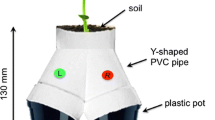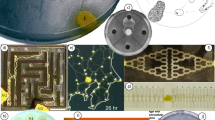Abstract
We describe hitherto unknown mechanoreceptors on the anterior spinnerets of the spiderCupiennius salei. These receptors are found at the base of the spigots of the major ampullate glands which produce the dragline used by the spider as a safety thread in various behavioral situations. There are 40–60 mechanoreceptors associated with two spigots of each anterior spinneret. They are likely to provide information on the forces pulling on the dragline and also on its orientation in space. A single sensillum consists of a hole in the cuticle covered by a thin cuticular membrane. It much resembles spider slit sensilla, which are known to detect strains in the exoskeleton. Each sensillum is supplied by two dendrites most likely belonging to two bipolar sensory cells. One of the dendrites ends at the covering membrane and the other more proximally. The sensilla are arranged with their long axes roughly parallel to the circumference of the spigots. External forces, transmitted by the dragline, result in deformation of the central part of the cuticular plate at the base of the spigots and thus in stimulation of the sensilla. This is shown electrophysiologicallly. Considering their morphology, topography, and electrophysiology, these mechanoreceptors are suggested to be important in the sensory control of dragline release by the spider.
Similar content being viewed by others
References
Apstein C (1889) Bau und Funktion der Spinndrüsen der Araneida. Arch Naturg 55:29–74
Barth FG (1971) Der sensorische Apparat der Spaltsinnesorgane (Cupiennius salei Keys., Araneae). Z Zellforsch Mikrosk Anat 112:212–246
Barth FG (1981) Strain detection in the arthropod exoskeleton. In: Laverack MS, Cosens D (eds) Sense organs, chapter 8. Blacky, Glasgow, pp 112–141
Barth FG (1985) Slit sensilla and the measurement of cuticular strains. In: Barth FG (ed) Neurobiology of arachnids. Springer, Berlin, pp 162–188
Barth FG, Libera W (1970) Ein Atlas der Spaltsinnesorgane vonCupiennius salei Keys. Chelicerata (Araneae). Z Morph Tiere 68:343–369
Barth FG, Blickhan R (1984) Arthropoda: Mechanoreception. In: Bereiter-Hahn J, Matoltsy AG, Sylvia Richards K (eds) Biology of the integument, vol 1: Invertebrates. Springer, Berlin Heidelberg New-York Toyko, pp 554–582
Barth FG, Komarek S, Humphrey JAC, Triedler B (1991) Drop and swing dispersal behavior of a tropical wandering spider: experiments and numerical model. J Comp Physiol A 169: 313–322
Breidbach O, Marx J (1989) Das Experiment: Neuronen in Blau. Methylenblau als ein Marker für Insektennervenzellen. Biol in unserer Zeit 2:59–61
Crome W (1957) Bau und Funktion des Spinnapparates und Analhügels, Ernährungsbiologie und allgemeine Bemerkungen zur Lebensweise vonUroctea durandi. Zool Jb Syst 85:571–606
Eberhard WG (1987) How spiders initiate airborne lines. J Arachnol 15:1–9
Ehlers M (1939) Untersuchungen über Formen aktiver Lokomotion bei Spinnen. Zool Jb Syst 72:373–499
Foelix RF, Schabronath J (1983) The fine structure of scorpion sensory organs. I. Tarsal sensilla. Bull Br arachnol Soc 6:53–56
Gnatzy W, Grünert U, Bender M (1987) Campaniform sensilla ofCalliphora vicina (Insecta, Diptera). I. Topography. Zoomorphol 106:312–319
Gorb SN, Barth FG (1994) Locomotor behavior during prey-capture of a fishing spiderDolomedes plantarius (Araneae: Araneidae): galloping and stopping. J Arachnol 22:89–93
Hess E, Vlimant M (1984) The distal tarsal slit sense organ (DTSSO), a new type of mechanoreceptor on the walking legs of the ixodid tickAmblyomma variegatum Fabricius 1794 (Ixodidae: Metastriata). Acarology 6:253–260
Hill DE (1979) Orientation by jumping spiders of the genusPhidippus (Araneae: Salticidae) during the pursuit of prey. Behav Ecol Sociobiol 5:301–322
Kovoor J, Peters HM (1988) The spinning apparatus ofPolenecia producta (Araneae, Uloboridae): structure and histochemistry. Zoomorphol 108:47–49
Maier L, Root TM, Seyfarth E-A (1987) Heterogeneity of spider leg muscles: histochemistry and electrophysiology of identified fibers in the claw levator. J comp Physiol B 157:285–294
Masuko K (1986) Motor innervation and proprioceptors of the mouthparts in the worker honey bee,Apis mellifera. I. Mandibular nerve. J Morphol 188:51–67
Mikulska I (1966) The spinning structures on the spinnerets (thelae) ofNephila clavipes L. Zool Pol 16:209–222
Mikulska I (1967) The external spinning structures of the thelae of the spiderArgiope aurantia Lucas. Zool Pol 17:358–365
Mittelstaedt H (1985) Analytical cybernetics of spider navigation. In: Barth FG (ed) Neurobiology of arachnids. Springer, Berlin, pp 298–316
Palmgren P (1980) Some comments on the anatomy of spiders. Ann Zool Fennici 17:161–173
Parry DA, Brown RHJ (1959) The jumping mechanism of salticid spiders. J Exp Biol 36:654–665
Peters HM (1955) Über den Spinnapparat vonNephila madagascariensis (Radnetzspinnen, Fam Argiopidae). Z Naturforsch B 10:395–404
Peters HM (1993a) Functional organization of the spinning apparatus ofCyrtophora citricola with regard to the evolution of the web (Aranea, Araneidae). Zoomorphol 113:153–163
Peters HM (1993b) Über das Problem der Stabilimente in Spinnennetzen. Zool Jb Physiol 97:245–264
Peters R (1967) Vergleichende Untersuchungen über Bau und Funktion der Spinnwarzen und Spinnwarzenmuskulatur einiger Araneen. Zool Beitr 13:29–119
Reynolds E (1963) The use of lead citrate at high pH as an electron-opaque stain in electron microscopy. J Cell Biol 17:208–212
Richardson KC, Jarett L, Finke EH (1960) Embedding in epoxy resins for ultrathin sectioning in electron microscopy. Stain Technol 35:313–325
Smith DS (1969) The fine structure of haltere sensilla in the blowfly,Calliphora erythrocephala (Meig), with scanning electron microscopic observations on the haltere surface. Tissue and Cell 1:443–484
Spurr AR (1969) A low-viscosity epoxy resin embedding medium for electron microscopy. J Ultrastructure Res 26:31–43
Author information
Authors and Affiliations
Rights and permissions
About this article
Cite this article
Gorb, S.N., Barth, F.G. A new mechanosensory organ on the anterior spinnerets of the spiderCupiennius salei (Araneae, Ctenidae). Zoomorphology 116, 7–14 (1996). https://doi.org/10.1007/BF02526925
Accepted:
Issue Date:
DOI: https://doi.org/10.1007/BF02526925




